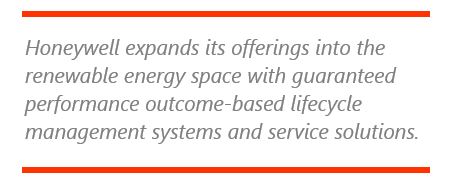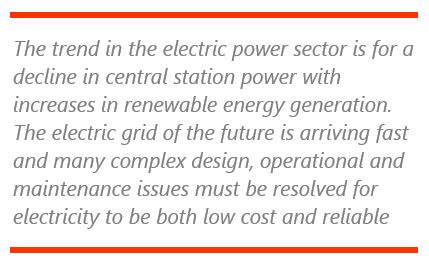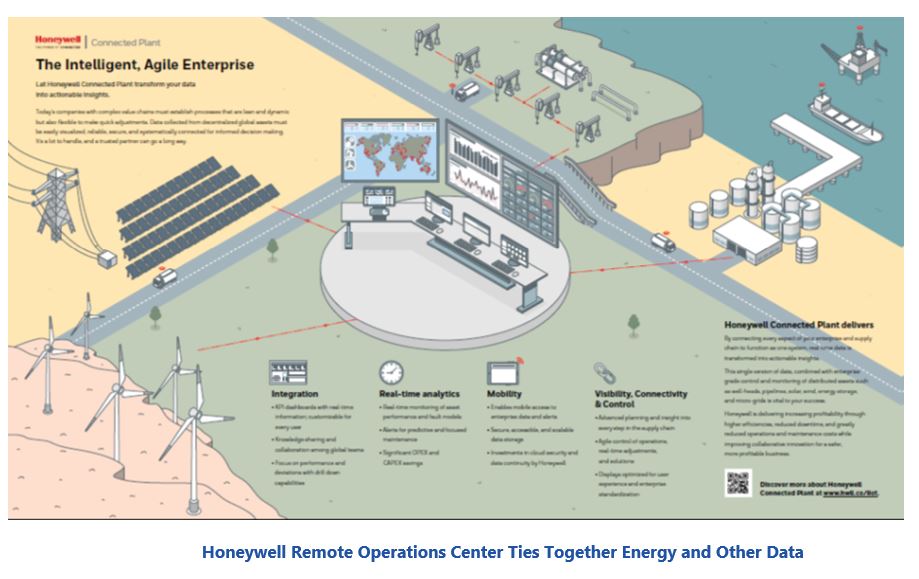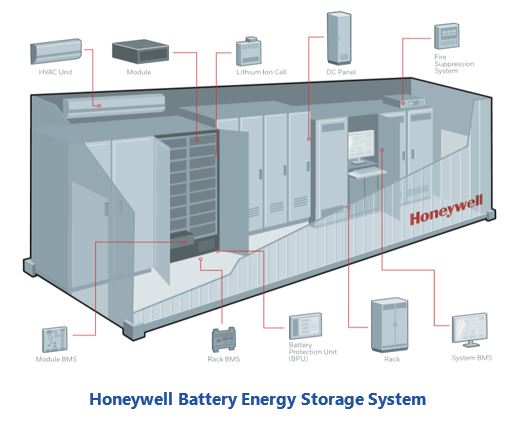

Eren Ergin, head of renewable energy at Honeywell Process Solutions (HPS), recently briefed ARC Advisory Group on his group’s recently introduced outcome-based lifecycle management approach for renewable energy assets.
Honeywell is an established worldwide provider of automation and process control systems and services for a 
Honeywell has created a new Renewable Energy group to focus on the unique needs of the growing renewable energy market segment. The group is focused on providing solutions to help users monitor, control, and manage their renewable energy assets. These include wind, solar PV, concentrated solar power (CSP), battery and thermal energy storage, biofuels, microgrids, geothermal, and integration with operation centers and grid, transmission, and distribution system operators. Significantly, Honeywell seeks to help asset owners and operators develop the future electric grid by assuming some of the risks associated with guaranteed performance.
This report reviews Honeywell’s outcome-based lifecycle management products and services as they apply to 
Key takeaways from this briefing include:
The energy industry is changing, with considerable growth in non-dispatchable renewable generation and declining central station power generation. This situation is further complicated by new microgrids appearing mostly on the distribution side of the electric network and shifting loads on transmission and distribution systems. Innovative solutions are needed to integrate these new renewable assets in a way that keeps power costs low and electric power reliable.
The trend towards declining use of fossil fuels for transportation and building HVAC will increase the demand for electric power over the next decade. Electric vehicles (EVs) will carry more of the transportation load and buildings will move towards electrically driven heat pumps and geothermal systems for HVAC.
The electric grid, already the largest and most complex system in the world, continues to get more complex as power is generated by many smaller intermittent generators and as ever smaller consumers are integrated into the grid operation with new demand response markets and systems.
The complexity of the equipment and controls that makes the electric grid work as a reliable, secure, unified system is only eclipsed by the constantly changing electric grid rules and regulations with local, state, and government systems. The methods employed to achieve the simple goals of low cost and high reliability vary widely geographically and are subject to environmental, technological, legal, and political constraints.
The large number of suppliers of renewable assets means that connecting assets together and then to an electric grid can be a challenging business and systems integration problem. Many planning mistakes have been made and business models failed by not understanding all the constraints. Virtually every microgrid or renewable asset has a unique situation related to local contractual obligations, hardware, and software along with specific rules and regulations. And, of course, there’s no shortage of uncertainty about how things will change over the life of that asset.
The right hardware, software, communications, security, and services must be assembled to achieve the KPIs identified by stakeholders. This typically requires putting together a systems integration team with the complete automation capability needed to gather appropriate measurements, integrate all subsystems, and provide appropriate software applications and user interfaces for all stakeholders.
This should enable operating the assets in a way that pushes against the most profitable constraints without damaging any equipment. The human asset is perhaps the most important part of the solution. All operations and maintenance staff need to be empowered with proper training support, and timely and actionable information. Engineering and business stakeholders also need to have access to the right information at the right time. Data collection and analytics can confirm proper operation and may be used to identify new opportunities to modify the assets or operate them in an optimal way. Honeywell’s Remote Operations Center ties all the data together from the operating level to the ERP level enabling interaction and coordination by all stakeholders on a single platform.

Different types of renewable generation require different management and control approaches. Solar PV system installers, for example, use a wide range of new products to collect, combine, and invert DC power and regulate interaction with loads, battery storage, and the grid. Solar CSP and geothermal systems are very similar to normal process control and building energy management systems. Wind turbines, in contrast, come with their own control systems and often with integrated vibration monitoring. Wind turbine manufacturers need to have remote access to their machines to provide support.
Ideally, to be able to add maximum value for any of these applications, technology and system integration suppliers like Honeywell should get involved early in the project development phase as consultants.

According to the company, operational and economic benefits are realized through reduced downtime, improved asset utilization, and increased worker efficiency, as well as reduced safety and compliance incidents. Users can establish a cyber- and physically secure infrastructure in compliance with NERC-CIP standards.
To help better manage the risks typically associated with renewable energy generation and grid integration, Honeywell Process Solutions provides an outcome-based lifecycle management program, offering contractual guarantees on mutually agreed KPIs.
Honeywell is expanding its already considerable process control and building management expertise to include monitoring, controlling, and managing distributed renewable generation, microgrids, grid-scale battery storage, and the integration of these assets with grid operators.
Honeywell’s approach to digitalizing renewable assets is designed to help transform an enterprise by connecting technology and people to meet strategic goals. Collecting the right data and putting that data to use requires experience integrating a wide range of instruments, controls, and digital devices. The goal is to help asset owners:
ARC has been monitoring how new technologies for digitalization, IIoT, and cloud computing are expanding the capabilities of asset management across many industries. The Honeywell approach to outcome-based lifecycle management for renewable energy projects combines the company’s subject matter expertise with its systems integration capabilities for industrial process control and building energy management.
ARC Advisory Group clients can view the complete report at ARC Client Portal
If you would like to buy this report or obtain information about how to become a client, please Contact Us
Keywords: Renewable Energy, BESS (Battery Energy Storage Systems), Wind, Solar, Geothermal, Electric Grid, Outcome-based Lifecycle Management, Energy Management, ARC Advisory Group.

